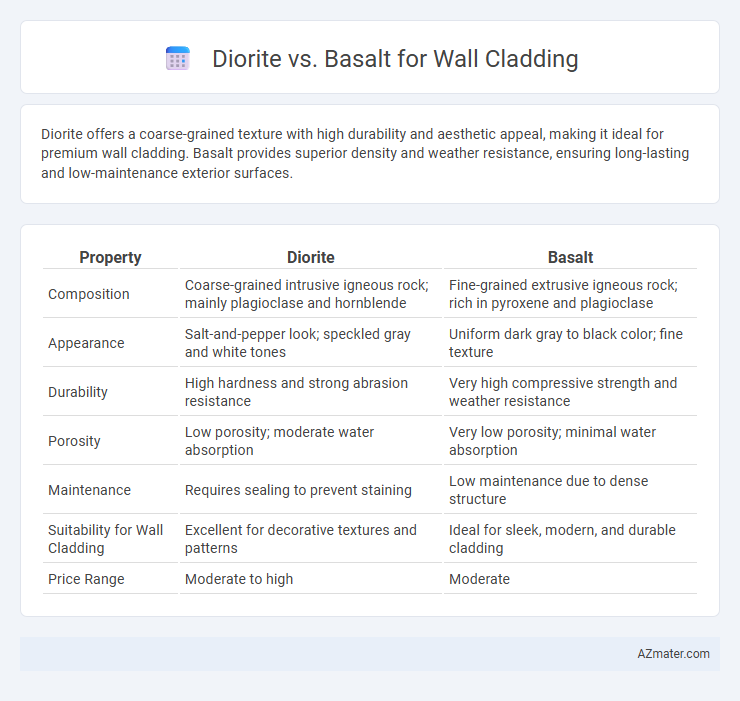Diorite offers a coarse-grained texture with high durability and aesthetic appeal, making it ideal for premium wall cladding. Basalt provides superior density and weather resistance, ensuring long-lasting and low-maintenance exterior surfaces.
Table of Comparison
| Property | Diorite | Basalt |
|---|---|---|
| Composition | Coarse-grained intrusive igneous rock; mainly plagioclase and hornblende | Fine-grained extrusive igneous rock; rich in pyroxene and plagioclase |
| Appearance | Salt-and-pepper look; speckled gray and white tones | Uniform dark gray to black color; fine texture |
| Durability | High hardness and strong abrasion resistance | Very high compressive strength and weather resistance |
| Porosity | Low porosity; moderate water absorption | Very low porosity; minimal water absorption |
| Maintenance | Requires sealing to prevent staining | Low maintenance due to dense structure |
| Suitability for Wall Cladding | Excellent for decorative textures and patterns | Ideal for sleek, modern, and durable cladding |
| Price Range | Moderate to high | Moderate |
Introduction to Wall Cladding Materials
Diorite and basalt are popular choices for wall cladding due to their durability and aesthetic appeal. Diorite exhibits a coarse-grained texture with a mix of light and dark minerals, offering a distinctive speckled appearance, while basalt features a fine-grained, uniform texture with a dark, solid color that complements modern designs. Both materials provide excellent weather resistance and structural strength, making them ideal for exterior and interior wall cladding applications.
Overview of Diorite and Basalt
Diorite is a coarse-grained igneous rock primarily composed of plagioclase feldspar and hornblende, known for its durability and attractive speckled appearance, making it a popular choice for wall cladding in architectural applications. Basalt, an extrusive igneous rock with a fine-grained texture, consists mainly of pyroxene and plagioclase, offering high density and resistance to weathering, which enhances its suitability for exterior wall cladding. Both materials provide strong structural benefits and aesthetic appeal, with diorite presenting a more polished look and basalt delivering enhanced heat resistance and longevity.
Geological Formation and Composition
Diorite, an intrusive igneous rock, forms from the slow cooling of magma beneath the Earth's surface, resulting in a coarse-grained texture rich in plagioclase feldspar, hornblende, and biotite. Basalt, an extrusive igneous rock, originates from rapid lava cooling at the surface, yielding a fine-grained composition dominated by pyroxene and plagioclase, with smaller amounts of olivine. These distinct geological formations influence their durability and aesthetic qualities, making diorite more granular and varied in texture compared to basalt's uniform, dense structure.
Physical Properties Comparison
Diorite exhibits a coarse-grained texture with high durability and a Mohs hardness of around 7, making it resistant to scratches and suitable for exterior wall cladding. Basalt is a fine-grained igneous rock known for its exceptional compressive strength and low porosity, ensuring excellent weather resistance and longevity in cladding applications. Both stones offer thermal stability and low water absorption rates, but basalt's uniform texture provides a sleek, modern appearance compared to diorite's speckled look.
Aesthetic Differences and Visual Appeal
Diorite features a coarse-grained texture with striking interlocking crystals in shades of grey, white, and black, offering a sophisticated, speckled appearance ideal for elegant wall cladding. Basalt presents a fine-grained, uniform texture with deep black or dark grey hues, lending a sleek, modern, and minimalist visual appeal to exterior or interior walls. The choice between Diorite and Basalt depends on desired aesthetics: Diorite's variegated surface creates a dynamic and natural look, while Basalt's consistent tone enhances contemporary designs with a polished, subtle elegance.
Durability and Weather Resistance
Diorite and basalt are both igneous rocks known for exceptional durability and weather resistance, making them ideal choices for wall cladding. Diorite offers a dense, coarse-grained texture with high compressive strength, resisting abrasion, chemical weathering, and freeze-thaw cycles effectively. Basalt's fine-grained, compact structure exhibits superior resistance to moisture penetration and thermal expansion, ensuring long-lasting performance in harsh environmental conditions.
Installation Techniques and Considerations
Diorite requires precise cutting and polishing due to its coarse-grained texture, making it essential to use diamond-tipped blades for clean edges during wall cladding installation. Basalt, being a denser volcanic rock, demands heavy-duty anchoring systems and careful handling to prevent fractures, especially when installed on vertical surfaces. Both materials benefit from moisture-resistant adhesives and sealants to enhance durability and prevent water infiltration in exterior cladding applications.
Maintenance and Longevity
Diorite offers exceptional durability and low maintenance for wall cladding due to its coarse-grained, hard composition that resists weathering and staining. Basalt, known for its fine-grained structure and high density, provides superior longevity and requires minimal upkeep, as it is highly resistant to abrasion and environmental damage. Both stones are ideal for long-term wall cladding applications, with basalt generally favored for more resistant exterior surfaces while diorite supports robust, enduring installations.
Cost Analysis for Diorite vs Basalt
Diorite typically costs more than basalt due to its rarity and distinctive coarse-grained texture, making it a premium choice for wall cladding projects. Basalt, being more abundant and easier to quarry, offers a cost-effective solution without compromising durability or aesthetic appeal. Project budgets favor basalt when large surface areas demand economical material usage, while diorite suits high-end installations where texture and visual impact justify higher expenditure.
Which Stone is Best for Your Wall Cladding Project?
Diorite offers a unique speckled appearance with high durability and excellent resistance to weathering, making it ideal for elegant and long-lasting wall cladding projects. Basalt, known for its fine-grained texture and dark, uniform color, provides superior strength and thermal insulation, perfect for modern designs requiring robust exterior protection. Choosing between Diorite and Basalt depends on aesthetic preferences and performance needs, with Diorite suited for intricate visual appeal and Basalt favored for enhanced durability and energy efficiency.

Infographic: Diorite vs Basalt for Wall Cladding
 azmater.com
azmater.com